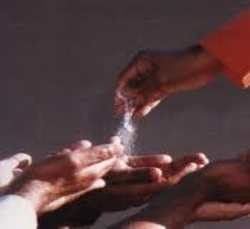The Answer Corner
Vol 4 号 5
September/October 2013
1. Question: I am not sure how to properly handle the SRHVP cards. Is it OK if I touch the face of the cards when removing them from the card box?
Answer: Before handling the cards, always wash your hands without using soap. Soap has a vibration, so washing in plain water avoids transferring the vibration of the soap to the cards. If you do wash with soap, thoroughly rinse (and dry) your hands with plain water three times to that the vibration of the soap is removed. Handle cards carefully. Do not touch the graphic area with your fingers; hold the card above the double line. If a card has fallen on the floor or needs cleaning, hold it above the double line on a clean hard surface and rub it with a new, soft, white, cotton handkerchief which has been thoroughly washed without detergent or soap.
_____________________________________
2. Question: What is the maximum time gap allowed between taking a blood sample and preparing the blood nosode?
Answer: Provided there is enough alcohol added to the blood sample, then a gap of a few days should not be a problem.
_____________________________________
3. Question: A patient complained that his chronic illness returned after 3 months of having been successfully treated through vibro. Could it be connected with his lifestyle?
Answer: Yes, lifestyle is a major cause of a chronic illness which is likely to return unless the patient changes to a healthy lifestyle. So, it is a good idea to talk to your patient at an appropriate time about good diet, exercise, relaxation, positive thoughts etc.
_____________________________________
4. Question: Please offer advice about the frequency of a remedy when a patient is acutely ill.
Answer: When the symptoms are highly acute eg, continuous diarrhoea, migraine headache or constantly running nose, the dosage may be increased to one dose (it is more effective if given in water) every 10 minutes for one hour. If the patient is not feeling better in one hour, then the dosage at ten minute intervals may continue for another hour. After that the patient should feel relief from his symptoms, in which case, the dosage should be reduced to 6TD for 1-2 days and TDS thereafter.
_____________________________________
5. Question: Flu season is fast approaching. I have not given remedies for acute conditions like flu or cold to prevent illness. If one person becomes ill, should I treat, as a preventative, the rest of the family members?
Answer: Remedies can be used as prophylactic for any illness without fear of any harm to the patient. It is better to start taking preventive dosage (which is as many doses per week as the normal dosage for the patient per day) when you are in the midst of sick people eg, when a member of the family or a colleague at work has fallen sick.
_____________________________________
6. Question: When interviewing a new patient who does not have a medical diagnosis, I find it difficult to determine the exact underlying cause of his problem?
Answer: If a patient asks for help but does not know why he is sick or feels bad, the best thing to do is to give him vibrations for the mind because the problem probably lies there.
During the initial appointment do not try to elicit personal background information unless the patient wants to give it. It is usual for you to have to wait for this knowledge until he is able to trust you. In this way you gain his confidence. During later visits, the patient might start to tell you about his deep seated fears and disappointments. He may not have spoken about these to anyone before. One of the important questions to ask the patient is what he thinks is the cause of the illness or symptoms. This in turn will help you to discover the underlying cause and treat accordingly.
_____________________________________
